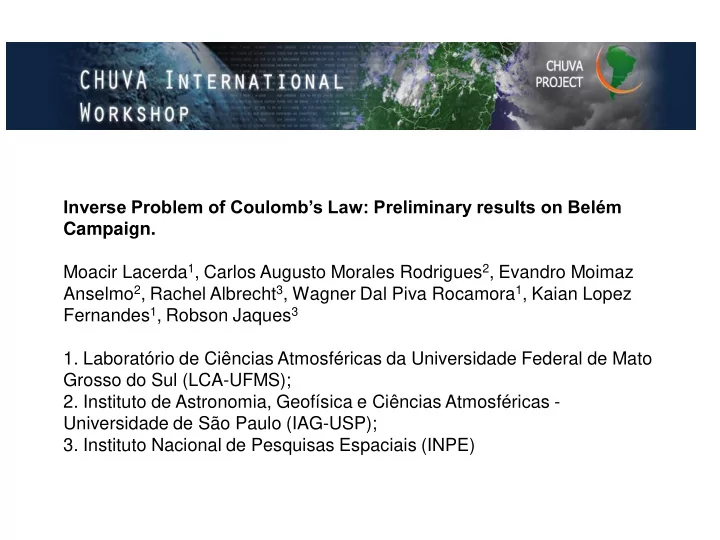

Inverse Problem of Coulomb’s Law: Preliminary results on Belém Campaign. Moacir Lacerda 1 , Carlos Augusto Morales Rodrigues 2 , Evandro Moimaz Anselmo 2 , Rachel Albrecht 3 , Wagner Dal Piva Rocamora 1 , Kaian Lopez Fernandes 1 , Robson Jaques 3 1. Laboratório de Ciências Atmosféricas da Universidade Federal de Mato Grosso do Sul (LCA-UFMS); 2. Instituto de Astronomia, Geofísica e Ciências Atmosféricas - Universidade de São Paulo (IAG-USP); 3. Instituto Nacional de Pesquisas Espaciais (INPE)
The inverse problem )
RADAR BENE OUT AERO -48.4583 -1.4749 -48.3017 -1.3167 -48.447 -1.2673 -48.4824 -1.3845 BENE = Benevides, OUT = Outeiro, AERO = Aeroporto. Field mill network
methodology • Step1. Analize radar image to localize the possible centers of charge Pj(xj, yj, zj). • Step2. Construct the function Ri,j, where the index i refers to the position of field mill and j refers to the center of charge. . Step 3.Calculate column vetor • . Step 4 . Use Coulomb’s Law to calculate the direct value • Ec i = Σ ij (R ij ⋅ q j ) for fitting data
Results: STEP1 Figure 4. Representation of Rhi during a thunderstorm. The black crosses represent regions with reflectivity greater than 45 dBz..
Step 2 and 3 R11 R12 := R R21 R22 R31 R32 ( ) Qp2=0 = = = = = = E1c 687.734 E1 925.4 E2c 2161.2655 E2 2829.769 E3c 2057.6156 E3 1276
STEP 4 Electric Field 2500 2000 1500 Benevides E (V/m) fmBEN 1000 500 EcBEN 0 -500 18 19 20 21 22 -1000 time (hour) Outeiro Electric Field 2500 2000 1500 E (V/m) 1000 Aeroporto fmAE 500 R 0 -500 18 18,5 19 19,5 20 20,5 21 21,5 22 -1000 time (hour)
Calculated results 1 (matrix) file h1 (m) h2 (m) h1+h2/10 q1 (C) q2 (C) 0 1a 2000 6000 2060 -853 418 1 2000 7000 2070 -622 307 2 2000 8000 2080 -490 245 3 2000 9000 2090 -403 208 6b 3000 6000 3060 -723 506 4 3000 7000 3070 -511 352 5 3000 8000 3080 -390 273 6 3000 9000 3090 -314 277 7 4000 7000 4070 -524 439 8 4000 8000 4080 -379 321 9 4000 9000 4090 -295 259 9a 4500 9000 4590 -301 281 10 5000 7000 5070 -669 625 11 5000 8000 5080 -432 409 12 5000 9000 5090 -317 311 mean 3433 7800 -481.53 354.14
electric charge (file 201106212034solinv3) 2.(grafic) 800 5070, 625 600 3060, 506 4070, 439 2060, 418 5080, 409 400 3070, 352 4080, 321 5090, 311 2070, 307 4590, 281 3090, 277 4090, 259 2080, 245 2090, 208 200 Electric charge (C) q1 q2 0 1500 2000 2500 3000 3500 4000 4500 5000 5500 -200 5 1 9 0 4 7 2 1 3 - 1 3 - 3 , - 0 , - 0 , 9 , 0 9 0 0 5 9 9 9 4 0 0 7 4 0 3 9 3 3 5 0 3 - - 4 , 2 -400 0 - , 0 3 8 , 8 0 4 0 0 - 9 4 0 3 , 0 2 0 8 9 0 1 4 5 - 1 4 5 2 , 0 - 5 8 - , 0 0 , 7 0 2 0 7 3 0 4 2 -600 2 6 - 9 , 0 6 7 6 0 - 2 , 0 3 7 2 0 7 5 - , 0 6 0 3 -800 3 5 8 - , 0 6 0 2 -1000 height of the low center (m)
discussion • This methodology is not closed because • of the nature of the inverse problem that • has infinite solutions. • The increasing knowledge of position and • sign of charges means more confidence in calculated values of charge magnitude. • This knowledge can be given by balloons • (Stolzenburg et al. 1998a, b and c). • For a more detailed discussion on some • improvement of this methodology see for • exemple, Lacerda et al 2012b.
Conclusions • In this paper we present a methodology for calculating charge structure in convective clouds. The electric field measured by a network of field mill is fitted by calculated field and seems be in reasonable agreement. The magnitude and location of charge centers were calculated and charge magnitude is of order of 4 x10 2 C • q(3433) = -481.53 C q(7800)= 354.14 C • This result is greater than values presented in literature. For a better improvement of this methodology we recommend the use of other techniques that allow detect the position of centers and the sign of charges in that center.
• Thanks • moacirlacerda@gmail.com • moacir.lacerda@ufms.br
Recommend
More recommend